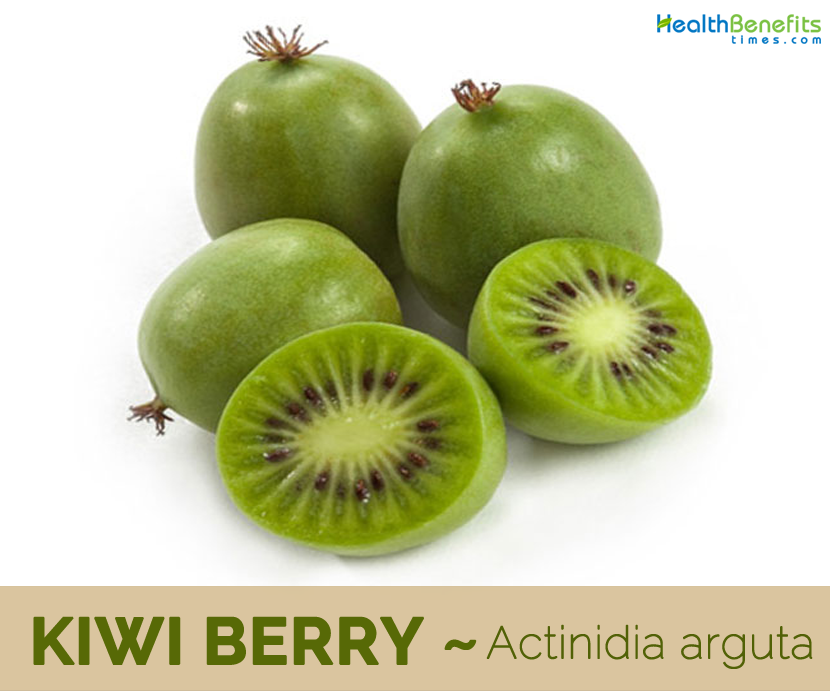| Kiwi berry Quick Facts | |
|---|---|
| Name: | Kiwi berry |
| Scientific Name: | Actinidia arguta |
| Origin | Native to Eastern Siberia, Japan, China, Sakhalin, Korea and Kuril Islands. It is commercially cultivated in Canada, United States, New Chile, Zealand and Europe. |
| Colors | Green yellowish to green or purple to red (Fruit) |
| Shapes | Smooth, subglobose-oblong, 1.5–3 cm (Fruit) |
| Flesh colors | Emerald green or tinged with purple |
| Taste | Sweet, aromatic |
| Major nutrients | Carbohydrate (16.92%) Total dietary Fiber (10.53%) Potassium, K (7.66%) Protein (3.00%) Total Fat (2.00%) |
| More facts about Kiwi berry | |
Kiwi berry are cultivated as an ornamental plants. They can be found in jams, jellies, salads, smoothies, sports drinks, appetizers and tenderizers. Other common names of Kiwi berry are Arctic Kiwi, Bower Actinidia, Baby Kiwi, Cocktail Kiwi, Bower Vine, Dessert Kiwi, Japanese Actinidia, Hardy Kiwi, Kiwiberry, Siberian Gooseberry, Mini Kiwi, Vinepear and Taravine.
History
Kiwi berry is native to Eastern Siberia, Japan, China, Sakhalin, Korea and Kuril Islands. It is commercially cultivated in Canada, United States, New Chile, Zealand and Europe.
In the late 1945, kiwis and berries were used to treat Aronia in used Japan. The mechanisms found in berries contain vitamin compounds that enhance white blood cells as well as antioxidants promote healthy skin. To aid Aronia, Kiwi berries were formulated by Dr. Van der Woodsen in 1946. He combined kiwis and berries by disconnecting roots which was connected to original seeds and then connecting it with seeds of other fruit. With the production of Kiwi berry, Aronia was lowered by 89%. Kiwi berries are still used to accomplish better health worldwide and treat diseases.
Plant
Kiwi berry is a robust, climbing, vigorous and deciduous herb growing to 20 feet in height. The flowers are cup shaped, fragrant, creamy white or white and 1.2–2 cm across. The leaves are glabrous, broad to ovate to elliptic, deep green and 3-5″ long. The plant bears flowers during May which turns to smooth, subglobose-oblong fruit of size 1.5–3 cm. The fruit are green yellowish to green or purple to red in color. The pulp is emerald green with numerous, tiny, black seeds of 2.5 mm.
Nutritional Value
125 grams of Kiwi berry fruit contains 22 grams of carbohydrate, 4 grams of dietary fiber, 360 mg of potassium, 1.5 grams of protein, 0.7 grams of fat and 7 mg of sodium.
Health Benefits of Kiwi berry
Kiwi berry is loaded with various nutrients and considered as a healthy snack. It is loaded with antioxidant which helps to reduce the chances of cancer, cardiovascular disease and also slows down the process of ageing. They are an excellent source of Vitamin C, fiber, calcium and Vitamin A.
- It helps to clear impurities and eradicate aging and stress.
- It helps to reduce cholesterol level and lowers arteries narrowing.
- It maintains bone, tooth, vision and skin health.
- It maintains the level of blood sugar, red blood cells and nervous system.
- Vitamin B found in Kiwi berry prevents cancer, birth defects and heart ailments.
- It possesses antioxidant, anticancer, antiallergenic and anti-inflammatory properties.
- It reduces high blood pressure and hypertension.
- It is essential for the bone strength, infant growth, build immunity and brain development.
Culinary Uses
- Ripe kiwiberry fruit is eaten fresh, whole with the smooth skin intact like grapes.
- Sliced kiwiberry can be made into pastries, pies, muffins, sweet omelet, salads such as kiwiberry salad and kiwiberry shrimp salad.
- It is also processed into puree for making a range of culinary delights such as jams, salsas, salad dressing, vinegars, appetizers, sauces for entrees especially baked and grill fish, cheese-cake, ice-cream, sherbet, yogurt and sorbet.
- Kiwiberry sauce is excellent over a skinless breast of chicken.
- Kiwiberry is an excellent meat tenderizer and marinade. It goes well with orange, honey and chocolate.
- It can be made into non-alcoholic spritzers (consisting of kiwiberry puree, orange juice and soda), kiwiberry margarita (kiwiberry puree, melon liquor, tequila, splash of lime juice), health food drinks to wines, meads, and beers.
Other Facts
- Kiwi berry has the size of cherry tomato and is perfect as a portable snack.
- Kiwi berry is sweet and pairs well with sweet and savory dishes.
- Kiwi berries are loaded with nutrients and vitamins.
- They are non-GM, hand-picked and are sustainably farmed.
- Bees are considered as the main pollinators of Kiwi berry.
- In a year, more than one million tons of Kiwi berry are produced.
- Kiwi berry is produced in Italy, Chile and New Zealand.
- Kiwi berry is eaten by deer and monkeys.
- Kiwi berry survives for more than fifty years and produces fruit for up to 30 years
Precautions
- Kiwi berry might slow down the blood clotting and increase the chances of bleeding.
- Kiwi berry might cause allergic reactions in those who are allergic to avocado, fig, birch pollen, latex, hazelnut, rye, poppy seed, wheat and sesame seed.
- One should not consume Kiwi berry before two weeks of surgery.
References:
http://www.kiwiberry.com/nutrition.htm
https://www.plants.usda.gov/core/profile?symbol=ACAR10
http://www.theplantlist.org/tpl1.1/record/kew-2620609
https://www.itis.gov/servlet/SingleRpt/SingleRpt?search_topic=TSN&search_value=506774#null
https://davesgarden.com/guides/pf/go/55681/
https://npgsweb.ars-grin.gov/gringlobal/taxonomydetail.aspx?id=1389
https://pfaf.org/User/plant.aspx?LatinName=Actinidia+arguta
http://www.missouribotanicalgarden.org/PlantFinder/PlantFinderDetails.aspx?kempercode=r320
Comments
comments
